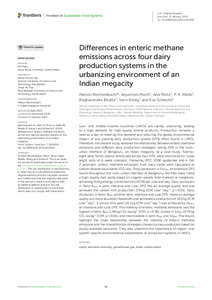| dc.date.accessioned | 2024-03-22T12:52:28Z | |
| dc.date.available | 2024-03-22T12:52:28Z | |
| dc.date.issued | 2024-01-17 | |
| dc.identifier | doi:10.17170/kobra-202403229853 | |
| dc.identifier.uri | http://hdl.handle.net/123456789/15594 | |
| dc.description.sponsorship | Gefördert durch den Publikationsfonds der Universität Kassel | |
| dc.language.iso | eng | |
| dc.rights | Namensnennung 4.0 International | * |
| dc.rights.uri | http://creativecommons.org/licenses/by/4.0/ | * |
| dc.subject | cattle | eng |
| dc.subject | emission intensity | eng |
| dc.subject | greenhouse gas | eng |
| dc.subject | India | eng |
| dc.subject | urbanization | eng |
| dc.subject.ddc | 630 | |
| dc.title | Differences in enteric methane emissions across four dairy production systems in the urbanizing environment of an Indian megacity | eng |
| dc.type | Aufsatz | |
| dcterms.abstract | Low- and middle-income countries (LMICs) are rapidly urbanizing, leading to a high demand for high-quality animal products. Production increase is seen as a key to meeting this demand and reducing the global environmental impact of low-yielding dairy production system (DPS) often found in LMICs. Therefore, the present study assesses the relationship between enteric methane emissions and different dairy production strategies, taking DPS in the rural–urban interface of Bengaluru, an Indian megacity, as a case study. Twentyeight dairy farms, evenly distributed across four DPS, were monitored for 1 year (eight visits at 6-week intervals). Following IPCC 2006 guidelines and a Tier 2 approach, enteric methane emissions from dairy cattle were calculated as carbon dioxide equivalents (CO2 eq). Dairy producers in ExtDPS, an extensive DPS found throughout the rural–urban interface of Bengaluru, fed their dairy cattle a high-quality diet, partly based on organic wastes from markets or neighbors, achieving 9.4 kg energy-corrected milk (ECM) per cow and day. Dairy producers in Semi-ADPS, a semi-intensive and rural DPS, fed an average quality diet and achieved the lowest milk production (7.9 kg ECM cow−1 day−1; p < 0.05). Dairy producers in Semi-BDPS, another semi-intensive and rural DPS, relied on average quality but more abundant feedstuffs and achieved a production of 10.0 kg ECM cow−1 day−1. A similar milk yield (10.1 kg ECM cow−1 day−1) was achieved by IntDPS, an intensive and rural DPS. The intensity of enteric methane emissions was the highest in Semi-BDPS (1.38 kg CO2-eq kg−1 ECM; p < 0.05), lowest in ExtDPS (0.79 kg CO2-eq kg−1 ECM; p < 0.05), and intermediate in semi-ADPS and IntDPS. The results highlight the close relationship between the intensity of enteric methane emissions and the intensification strategies chosen by dairy producers based on locally available resources. They also underline the importance of region- and system-specific environmental assessments of production systems in LMICs. | eng |
| dcterms.accessRights | open access | |
| dcterms.creator | Reichenbach, Marion | |
| dcterms.creator | Mech, Anjumoni | |
| dcterms.creator | Pinto, Ana | |
| dcterms.creator | Malik, Pradeep Kumar | |
| dcterms.creator | Bhatta, Raghavendra | |
| dcterms.creator | König, Sven | |
| dcterms.creator | Schlecht, Eva | |
| dc.relation.doi | doi:10.3389/fsufs.2023.1204218 | |
| dc.subject.swd | Indien | ger |
| dc.subject.swd | Milchwirtschaft | ger |
| dc.subject.swd | Milchproduktion | ger |
| dc.subject.swd | Verstädterung | ger |
| dc.subject.swd | Methanemission | ger |
| dc.type.version | publishedVersion | |
| dcterms.source.identifier | eissn:2571-581X | |
| dcterms.source.journal | Frontiers in Sustainable Food Systems | eng |
| dcterms.source.volume | Volume 7 | |
| kup.iskup | false | |
| dcterms.source.articlenumber | 1204218 | |


